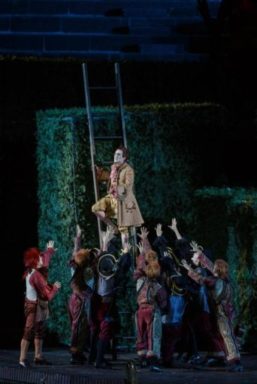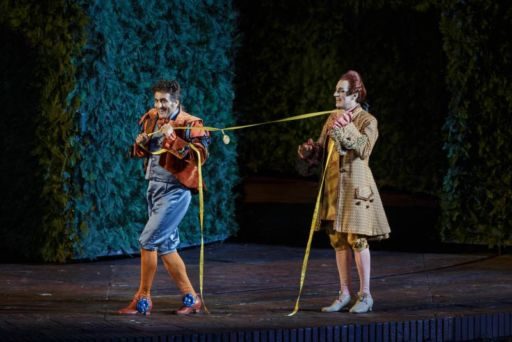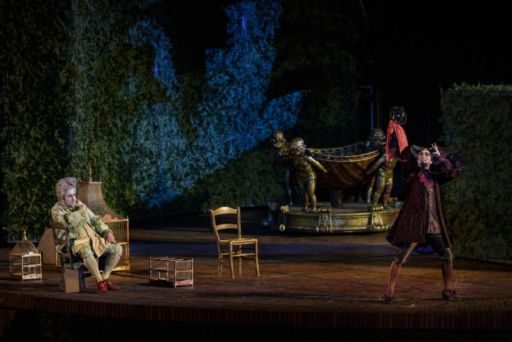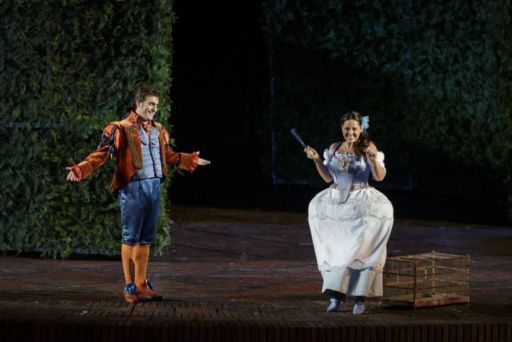Verona, Fondazione Arena di Verona. 96^ Opera Festival 2018.
“IL BARBIERE DI SIVIGLIA” (Il barbiere di Siviglia)
Opera in 2 acts, Text by C. Sterbini from a comedy by De Beaumarchais.
Composer Gioachino Rossini
Count Almaviva LEONARDO FERRANDO
Doctor Bartolo CARLO LEPORE
Rosina NINO MACHAIDZE
Figaro MARIO CASSI
Don Basilio ROMANO DAL ZOVO
Berta MANUELA CUSTER
Fiorello/Ambrogio NICOLÒ CERIANI
An officer GOCHA ABULADZE
Orchestra, coro e corpo di ballo dell’Arena di Verona
Conductor Andrea Battistoni
Chorus Master Vito Lombardi
Director, Costumes, Scenery and Lighting Hugo de Ana
Choreography Leda Lojodice
Verona, 17th August 2018.
 The third of five performances of The Barber of Seville at the Arena di Verona was that of a cast change in two of the principal roles, Mario Cassi taking over the role of Figaro from Leo Nucci and Leonardo Ferrando in his only performance as Count Almaviva. The revival of this very popular production, first seen in 2007, is Verona’s homage to the 150th anniversary of Rossini’s death this year. At its 4th revival and 11 years from its premier de Ana’s magical and elegant production continues to delight and enchant the audience. From the clapping prologue of the mimes the audience is joyously drawn into the festive action. The stage is occupied by an enormous platform on which huge maze-like hedges rotate to create spatially different scenes overshadowed by gigantic red roses. The soloists, chorus, ballet dancers and mimes are Lilliputian in comparison. A seemingly impossible task of staging such a delicate opera in such a vast space is resolved by creating a fantasy world to accomodate quick stage entries, exits and scene changes and create intimacy. The production is laced with irony and a sense of the grotesque. Bizarre and extravagant dancers, acrobats and mimes, reminiscent of Alice in Wonderland, in exquisite 18th century costumes, designed by de Ana, and their music box figures and movements, a mix of minuet and modern, all cleverly and tastefully choreographed by Leda Lojodice, enliven the staging, as a frame and comment on the opera. An engaging cast breathed life into the production. Leonardo Ferrando’s opening serenade “Ecco ridente in cielo”immediately revealed an excellent use of sustained breath control, easy emission and agility, particularly evident in a bright and ringing high register and a smooth and graceful lyrical line. Nino Machaidze was a charming Rosina, musically and technically precise, with a full rounded timbre and seamless extension, she executed the coloratura appropriately but without sparks. Mario Cassi as
The third of five performances of The Barber of Seville at the Arena di Verona was that of a cast change in two of the principal roles, Mario Cassi taking over the role of Figaro from Leo Nucci and Leonardo Ferrando in his only performance as Count Almaviva. The revival of this very popular production, first seen in 2007, is Verona’s homage to the 150th anniversary of Rossini’s death this year. At its 4th revival and 11 years from its premier de Ana’s magical and elegant production continues to delight and enchant the audience. From the clapping prologue of the mimes the audience is joyously drawn into the festive action. The stage is occupied by an enormous platform on which huge maze-like hedges rotate to create spatially different scenes overshadowed by gigantic red roses. The soloists, chorus, ballet dancers and mimes are Lilliputian in comparison. A seemingly impossible task of staging such a delicate opera in such a vast space is resolved by creating a fantasy world to accomodate quick stage entries, exits and scene changes and create intimacy. The production is laced with irony and a sense of the grotesque. Bizarre and extravagant dancers, acrobats and mimes, reminiscent of Alice in Wonderland, in exquisite 18th century costumes, designed by de Ana, and their music box figures and movements, a mix of minuet and modern, all cleverly and tastefully choreographed by Leda Lojodice, enliven the staging, as a frame and comment on the opera. An engaging cast breathed life into the production. Leonardo Ferrando’s opening serenade “Ecco ridente in cielo”immediately revealed an excellent use of sustained breath control, easy emission and agility, particularly evident in a bright and ringing high register and a smooth and graceful lyrical line. Nino Machaidze was a charming Rosina, musically and technically precise, with a full rounded timbre and seamless extension, she executed the coloratura appropriately but without sparks. Mario Cassi as Figaro took possession of the stage from his entrance with his easy going stage manner and commanding vocal presence. A strong, full, clearly articulated, and dynamic voice was moulded with expressivity and musicality. His cavatina “Largo al factotum” received an ovation and was encored. Carlo Lepore’s Don Bartolo was a lesson in taste, measure, comic timing both in his stagecraft and his vocality. His diction was perfect and fired at speed when called for. His “buffo” was played in a direct and natural way without ever confounding a fine voice and solid technique. Vocally secure, Romano Dal Zovo managed to communicate the devious and duplicitous character of Don Basilio without ever losing his smooth and even vocal delivery and Manuela Custer’s Berta was a treat. Her arietta was projected effortlessly with a bright firm tone. Custer, Lepore and Dal Zovo all managed to be entertaining and at the same time adopt the right register in their “buffo” characters avoiding forced comedy, over acting or adopting fastidious vocal mannerisms. Nicolò Ceriani, a valid Fiorello/Ambrogio and Gocha Abuladze, an officer, completed the cast. The male chorus prepared by Vito Lombardi were in fine form. Despite the wonderful staging contrivances the problem remains that this type of opera is lost in the enormous distances of the Arena. In the first row of the prima gradinata, the clavicembalo was inaudible and the lightweight and numerically reduced orchestra conducted with energy and verve by Andrea Battistoni resulted very distant and vague.The explosion of fireworks at the end remains a marvellous conclusion to a magical evening. Photo Ennevi
Figaro took possession of the stage from his entrance with his easy going stage manner and commanding vocal presence. A strong, full, clearly articulated, and dynamic voice was moulded with expressivity and musicality. His cavatina “Largo al factotum” received an ovation and was encored. Carlo Lepore’s Don Bartolo was a lesson in taste, measure, comic timing both in his stagecraft and his vocality. His diction was perfect and fired at speed when called for. His “buffo” was played in a direct and natural way without ever confounding a fine voice and solid technique. Vocally secure, Romano Dal Zovo managed to communicate the devious and duplicitous character of Don Basilio without ever losing his smooth and even vocal delivery and Manuela Custer’s Berta was a treat. Her arietta was projected effortlessly with a bright firm tone. Custer, Lepore and Dal Zovo all managed to be entertaining and at the same time adopt the right register in their “buffo” characters avoiding forced comedy, over acting or adopting fastidious vocal mannerisms. Nicolò Ceriani, a valid Fiorello/Ambrogio and Gocha Abuladze, an officer, completed the cast. The male chorus prepared by Vito Lombardi were in fine form. Despite the wonderful staging contrivances the problem remains that this type of opera is lost in the enormous distances of the Arena. In the first row of the prima gradinata, the clavicembalo was inaudible and the lightweight and numerically reduced orchestra conducted with energy and verve by Andrea Battistoni resulted very distant and vague.The explosion of fireworks at the end remains a marvellous conclusion to a magical evening. Photo Ennevi
 Alla sua quarta ripresa, e a undici anni dalla sua creazione, questo Barbiere di Siviglia firmato de Ana continua a deliziare e incantare il pubblico. Già dal balletto che anima la sinfonia gli spettatori si immergono nel grande giardino con le sue gigantesche rose rosse. L’impresa, apparentemente impossibile di mettere in scena un’opera così delicata in uno spazio così vasto, viene risolto creando un mondo fantastico in grado di accogliere entrate, uscite e cambiamenti di scena veloci e allo stesso modo creare intimità. Uno spettacolo intriso di ironia e un tocco di grottesco: ballerini stravaganti, acrobati e mimi (che ricordano Alice nel Paese delle Meraviglie, in squisiti costumi del 18 ° secolo) con le loro figure e movimenti, un mix tra minuetto e danza moderna, sapientemente creati da Leda Lojodice, fanno da cornice all’azione dei protagonisti. Un cast coinvolgente e ben amalgamato nel riprodurre la regia di de Ana. La serenata di apertura dell’Almaviva di Leonardo Ferrando (al suo esordio areniano), “Ecco ridente in cielo”, ha immediatamente rivelato una bella linea di canto, un ottimo uso e controllo del fiato, facilità di emissione e delle agilità. Bello anche il registro acuto, brillante e squillante. Nino Machaidze è un’affascinante Rosina, musicalmente e tecnicamente precisa, con un timbro pieno e omogeno. Il canto di coloratura è preciso ma senza scintille. Mario Cassi nel ruolo di Figaro si è
Alla sua quarta ripresa, e a undici anni dalla sua creazione, questo Barbiere di Siviglia firmato de Ana continua a deliziare e incantare il pubblico. Già dal balletto che anima la sinfonia gli spettatori si immergono nel grande giardino con le sue gigantesche rose rosse. L’impresa, apparentemente impossibile di mettere in scena un’opera così delicata in uno spazio così vasto, viene risolto creando un mondo fantastico in grado di accogliere entrate, uscite e cambiamenti di scena veloci e allo stesso modo creare intimità. Uno spettacolo intriso di ironia e un tocco di grottesco: ballerini stravaganti, acrobati e mimi (che ricordano Alice nel Paese delle Meraviglie, in squisiti costumi del 18 ° secolo) con le loro figure e movimenti, un mix tra minuetto e danza moderna, sapientemente creati da Leda Lojodice, fanno da cornice all’azione dei protagonisti. Un cast coinvolgente e ben amalgamato nel riprodurre la regia di de Ana. La serenata di apertura dell’Almaviva di Leonardo Ferrando (al suo esordio areniano), “Ecco ridente in cielo”, ha immediatamente rivelato una bella linea di canto, un ottimo uso e controllo del fiato, facilità di emissione e delle agilità. Bello anche il registro acuto, brillante e squillante. Nino Machaidze è un’affascinante Rosina, musicalmente e tecnicamente precisa, con un timbro pieno e omogeno. Il canto di coloratura è preciso ma senza scintille. Mario Cassi nel ruolo di Figaro si è impadronito della scena con la sua brillante presenza vocale e scenica. Una voce, la sua, robusta, piena, con una chiara articolazione del fraseggio. Un Figaro, quello di Cassi, plasmato con espressività e musicalità. La sua cavatina “Largo al factotum” è stata salutata da una vera e propria ovazione. In Don Bartolo, Carlo Lepore offre una lezione di gusto, misura, tempismo comico sia nella recitazione che nella vocalità. La sua dizione era perfetta e lanciata alla velocità del canto sillabato richiesto. Il suo essere “buffo” è stato sempre diretto e senza eccessi che andassero a inficiare la bella vocalità. Vocalmente sicuro, Romano Dal Zovo è riuscito a comunicare il carattere subdolo e ambiguo di Don Basilio senza mai perdere di vista la fluidità e la naturalezza del canto. Brillante la Berta di Manuela Custer: ha fatto della sua arietta un piccolo capolavoro di proiezione vocale, sicurezza e brillantezza. Un valido Nicolò Ceriani (Fiorello / Ambrogio) e Gocha Abuladze (Un ufficiale) completano il cast. In ottima forma il coro maschile preparato da Vito Lombardi era in ottima forma. Se dal punto di vista vocale e scenico questo Barbiere ha saputo trovare una funzionale soluzione, le cose vanno meno bene sul piano strumentale: già nella prima fila della prima gradinata, il clavicembalo era impercettibile e le sonorità orchestrali (compagine numericamente ridotta), benchè gestite con energia e verve da Andrea Battistoni, risultavano molto distanti e vaghe. Comunque sia, l’esplosione dei fuochi d’artificio finali sono a corollario di un’altra magica serata areniana. Foto Ennevi
impadronito della scena con la sua brillante presenza vocale e scenica. Una voce, la sua, robusta, piena, con una chiara articolazione del fraseggio. Un Figaro, quello di Cassi, plasmato con espressività e musicalità. La sua cavatina “Largo al factotum” è stata salutata da una vera e propria ovazione. In Don Bartolo, Carlo Lepore offre una lezione di gusto, misura, tempismo comico sia nella recitazione che nella vocalità. La sua dizione era perfetta e lanciata alla velocità del canto sillabato richiesto. Il suo essere “buffo” è stato sempre diretto e senza eccessi che andassero a inficiare la bella vocalità. Vocalmente sicuro, Romano Dal Zovo è riuscito a comunicare il carattere subdolo e ambiguo di Don Basilio senza mai perdere di vista la fluidità e la naturalezza del canto. Brillante la Berta di Manuela Custer: ha fatto della sua arietta un piccolo capolavoro di proiezione vocale, sicurezza e brillantezza. Un valido Nicolò Ceriani (Fiorello / Ambrogio) e Gocha Abuladze (Un ufficiale) completano il cast. In ottima forma il coro maschile preparato da Vito Lombardi era in ottima forma. Se dal punto di vista vocale e scenico questo Barbiere ha saputo trovare una funzionale soluzione, le cose vanno meno bene sul piano strumentale: già nella prima fila della prima gradinata, il clavicembalo era impercettibile e le sonorità orchestrali (compagine numericamente ridotta), benchè gestite con energia e verve da Andrea Battistoni, risultavano molto distanti e vaghe. Comunque sia, l’esplosione dei fuochi d’artificio finali sono a corollario di un’altra magica serata areniana. Foto Ennevi
